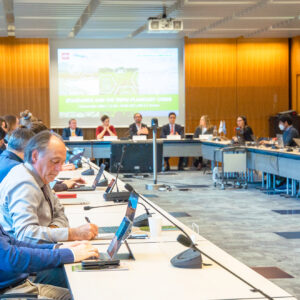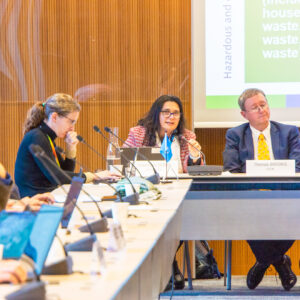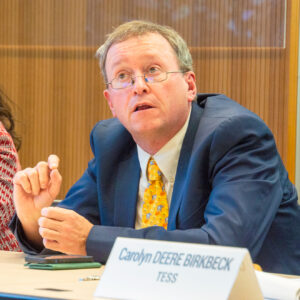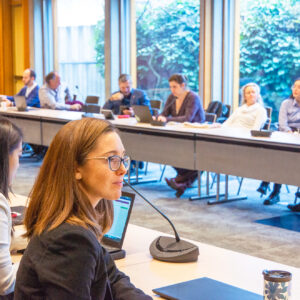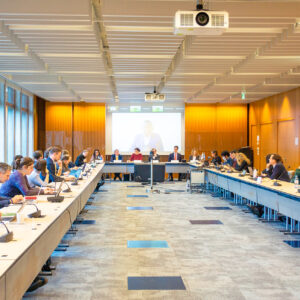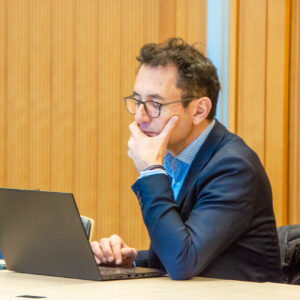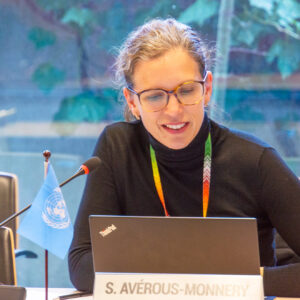Event Conference
Standards and the Triple Planetary Crisis
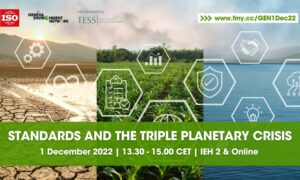
01 Dec 2022
13:30–15:00
Venue: International Environment House II & Online
Organization: International Organization for Standardization, Geneva Environment Network
International standards can be a powerful tool to address the triple planetary crisis of climate change, biodiversity loss and pollution. Collaboration between actors in Geneva and beyond will be key to leverage standards to achieve the Sustainable Development Goals. This event, organized by the International Organization for Standardization (ISO) and the Geneva Environment Network, gathered experts and stakeholders to explore how standards can support the implementation of environmental policy frameworks to tackle the triple planetary crisis.

About
Today, humanity is facing a triple planetary crisis: climate change, nature and biodiversity loss, pollution. These intertwined challenges are threatening the well-being and survival of millions of people around the world and jeopardizing the Sustainable Development Goals (SDGs). Addressing the triple planetary crisis requires collaborative action from all side of society to restore harmony with nature and foster a transition to sustainable socio-economic systems.
Multilateralism is key to address the triple planetary crisis, but ambition and commitments at the global level can only be effective if they are translated into concrete action. International standards can support this process, as they can be used as tools to implement environmental policy frameworks. International standards can provide methodologies, definitions, and measurement criteria that lay down a common foundation for global action. They can give detailed and precise information to business, governments, civil society, municipalities and the public on how to translate a policy goal into action globally. Conformity assessment standards can then help build trust and increase confidence that these policy objectives are truly being met.
Most international standards are regulation-ready and many are already used to support national climate and environmental policies. Through their transparent, multi-stakeholder and consensus-based development process, international standards can also support cross-sectoral dialogue between scientific experts, industry partners and policymakers. International standards are an important contribution to closing the implementation gap and moving from agreement to collective action.
As a global hub for both environmental governance and standardization, Geneva can play a key role in fostering collaboration across organizations and with stakeholders to develop international standards that will support the implementation of environmental policy frameworks, thus contributing to effectively addressing the triple planetary crisis. Convened by ISO and the Geneva Environment Network, this hybrid event explored the role of international standards in multilateral action to tackle biodiversity loss, reduce pollution, and mitigate and adapt to climate change.
Speakers
By order of intervention.

Sergio MUJICA
Secretary-General, International Organization for Standardization (ISO)

Daniela GARCIA FREIRE
Deputy Permanent Representative of Ecuador to the World Trade Organization (WTO)

Massamba THIOYE
Project Executive, UNFCCC Global Innovation Hub

Mateo FERRERO
Trade and Environment Division, World Trade Organization (WTO)

Thomas BROOKS
Chief Scientist, International Union for Conservation of Nature (IUCN)

Justin WILKES
Executive Director, Environmental Coalition on Standards (ECOS)

Sandra AVÉROUS-MONNERY
Acting Head, Knowledge and Risk Unit, Chemicals and Health Branch, United Nations Environment Programme (UNEP)
Highlights
#Live now!
Join the experts and stakeholders who will explore how we can support the implementation of environmental policy frameworks to tackle the #tripleplanetarycrisis through #standards.
Livestream available ➡️ https://t.co/H3EykGApU6 pic.twitter.com/yFDcJddrNJ
— GENeva Environment Network (@GENetwork) December 1, 2022
Video
Photo Gallery
Summary
Welcome & Introduction
Sergio MUJICA, ISO
It’s really a pleasure to have you all participating in this event.
Let me start by saying a few words about ISO. We are the International Organization for Standardization. We were created in 1947, right after World War II, because it was already understood at that moment that if we wanted to rebuild the world, we needed international standards. And we are of course based here in Geneva. But ISO is so much more than a building in Geneva. It is a system. It is a family as I like to call it.
The key elements are number one: Membership. We have 165 members from all around the world. We are proud to be a member driven organization. So we have the governance infrastructure to make sure that it is the members who take the main decisions for the organization, both at the governance level as well as the technical level.
The second key pillar is our technical community, because we don’t write our standards here in Geneva. The standards are written by technical committees, nearly 800 of them if we also consider the subcommittees, and they do it in a very collaborative manner. We have an incredible network of over 50,000 international experts that have been appointed by the members.
They take decisions by consensus and are basically trying to figure out what is the best way to do something. What’s the best way to create a product. What is the best possible process or the way to provide a service. We have a portfolio of around 24,000 international standards but ISO is so much more than that. It is not only the standard that matters here in the case of ISO. The process, the how, is just as important as the deliverable because we believe in a decision-making process that is based on consensus.
It is not necessarily an easy thing to achieve. But it’s so important. We work in a transparent manner with full inclusivity. And we also take care of the developmental dimension because we provide capacity building to our members. The “how” is essential, as I mentioned before, and we deeply believe in collaboration as a core value of our proposition. Collaboration first with other international organizations because standardization can be a crowded field. It’s very important that we coordinate our efforts with others and we do not duplicate or overlap the portfolio of standards. Collaboration among the experts, of course, because they need to provide technical expertise, but at the same time to make sure that decisions are there by consensus. Collaboration with stakeholders, with civil society and in the end it’s about the value of incorporating all voices in your decision-making process.
Some of the key stakeholders we engage with are policymakers and regulators. Many people tend to believe that standards are another layer of regulations. But that is not the case. Most of our standards are voluntary, but we work closely with policymakers and regulators to support them in the acceleration of the implementation of the regulations. We do not compete with them, we support them. And actually many of our standards are incorporated into regulations.
Not only that, the World Trade Organization – through the TBT agreement – recommends that if you’re going to have regulations, in order for them not to be considered technical barriers to trade, they should use international standards. So that is the value proposition and why we collaborate with other international organizations and with policymakers. That is ISO.
Now, why are we here today? There are three key topics, three key challenges that we have to address. They are climate change, biodiversity loss, and pollution. And those really represent a multitude of challenges, not only for governments but for all kinds of organizations, industry, academia, everyone. These issues cannot be addressed in isolation because if you’re trying to fix climate change you might create a new problem for biodiversity loss, or and you can create a new problem of pollution. We really need to have a holistic approach here.
What is essential when addressing that triple challenge, if you wish, is that it takes a common understanding of the underlying issue. We cannot jump into solutions if we do not understand what we’re trying to fix. We don’t want solutions looking for problems. We need to understand the issue we have in front of us and to agree on the common terminology.
Secondly, we need a shared framework. We will address this in a collaborative manner. We will not be overlapping or competing with our various solutions. I believe that international standards are the ideal tool to support that process. So let me give you a couple of examples about what ISO is doing about those three challenges we are facing, starting with climate change.
ISO has been working on climate change and the environment for many, many years. We have a large portfolio related to those topics. But what has changed is the public commitment we made as an international organization, including all our 165 members, exactly a year ago with ISO’s Climate commitment or what we call the ISO Climate Declaration. But of course, the declaration means very little if you are not able to translate it into very concrete actions so we have an Action Plan and Noelia [Garcia Nebra; ISO’S Head of Sustainability] is in charge of that. It’s quite a big responsibility, composed of three main pillars.
The first one is about our core business; standardization. What we’re doing there is to create a mapping of our standards because we cannot offer 24,000 international standards and tell everyone, “use them wisely”. It doesn’t work like that. We need to identify what is really essential, what is impactful to support organizations to implement their commitments on climate change. But when you do a mapping, it’s very interesting not only to find out what you have there, but also what you don’t have there, what kind of gaps we have today. Then we can mobilize our standardization and development process to respond to those needs. You also need to understand what needs to be updated – the revision of our standards – because many of them were made at a different point in time, perhaps when climate change was very different in terms of priority, or in terms of the various alternatives available to comply with your commitments. So this work will help us identify gaps, potential revisions, and ways of better including climate science, which needs to be a core voice within our standard development process. That’s pillar number one.
Pillar number two is on partnerships. We cannot address climate change working in isolation. We know that we need to team up with other organizations, we need to include civil society and experts in that effort. Partnership is easy to say, it’s not so simple to achieve in practice. This is a very crowded field and there is competition. We have to combine our talents so that we can offer something that makes sense to the public and to organizations.
And the third one is about capacity building. We need to mobilize all of our 165 members so they can be an instrument of change, an instrument of implementation in all their respective countries. We have a strong program to enable our members – the ISO members – to deliver both at the national and at the international level.
So that’s the first challenge, climate change. The second one is biodiversity loss. In that area, we already have technical committee in place specifically on Biodiversity which is working on addressing a range of issues such as ecological engineering, nature-based solutions and relevant technologies. Through this work we are aiming to help ensure long term biodiversity conservation. In very practical terms, what we have tried to do here is to define some principles and a common language. We should try to have the same understanding of the key concepts related to biodiversity.
We are also working on measurement because there is scope for green washing. Here we need to understand how we will measure and what kind of data we will use here. Then restoration, conservation and protection, and finally organization and the strategies that we can use to deal with this topic. We will be participating in COP15 next week in Montreal, because we also want to show the international community that they can use international standards to implement what is being by the parties of this international agreement.
The third element is about pollution. As we speak, we have an ISO team participating in the very first round of negotiations taking place in Punta del Este, Uruguay, to create an international legally binding instrument on plastic pollution, including in the marine environment. Once again, it’s very important to put in the mind of the negotiators that if they want to transform their commitments into reality, international standards can help. We also have technical committees that have been working for many, many years on this topic.
At the end of the day, it is all about collaboration. We launched ISO’s Net Zero Guidelines at COP 27 in November. We’re trying to provide common terminology and some guiding principles. At COP 26 in Glasgow a year ago, the UN Secretary General said that “there is a surplus of confusion and lack of credibility when it comes to Net Zero”. He created a UN high-level expert group precisely to try to define in a manner that makes sense to everyone what this means and how we can achieve that. It’s very interesting to see that when the outcome of high-level working group was launched at COP 27, international standards were mentioned as one of the key instruments that can be used when it comes to prove that the methodology is a good one in order to claim net zero, for example. So that’s a good example of how collaboration can help us to implement our commitments. That’s the key message number one.
The second one is a sense of urgency on the Triple Planetary Crisis. We need to collaborate so that we can deliver better solutions.
And the third one is to put in everybody’s mind the possibility of using international standards to accelerate implementation of decisions.
With that, I thank you all of you for attending this conference. I understand it’s going to be the first one of many. I think we have discovered how interesting it could be to keep working together.
Member State Perspectives
Daniela GARCIA FREIRE, Deputy Permanent Representative of Ecuador to WTO (Online, live from Plastic Pollution INC1 in Punta del Este)
Ecuador is pleased to join the discussion and the variety of friends present in the room today. This shows the diversity of experts involved in the issue of standards.
The secretary General of ISO presented the important role of standards to contribute to tackle the triple planetary crisis, of pollution, the loss of biodiversity and climate change. We need a better and comprehensive understanding, as governments and policy makers, on these topics that will definitely contribute to the diversity of challenges we face.
The role of the standards, as it was well mentioned, is instrumental to support effective implementation of environmental treaties, and there was already mention of the example of the future global Treaty to end plastic pollution, but also, in terms of key biodiversity parameters that are very important for countries such as Ecuador. On cacao, coffee, etc., it has been instrumental to work with standards, voluntary standards, sustainability standards, in terms of market criteria to contribute to these sectors that represent an important economic contribution to our countries. Many economies depend on these sectors.
Standards together with other instruments can help to set and verify targets, to address these different topics, including when we talk about climate change, pollution and biodiversity loss. There is a good example in terms of circular economy and how is has been implemented in Ecuador, and how we have been working in terms of standards for services, in our recycling processes. Indeed, standards are not only relevant in terms of products but also in terms of processes.
At WTO, member states are working together with ISO in the dialogues on plastic pollution, coordinated by Ecuador, Australia, Barbados, China, Ecuador, Fiji and Morocco, with a great part of contribution of dialogue intense on collective approaches. We look forward to contributing from that broad to the [Plastic Pollution] INC negotiation to improve the understanding of negotiators on the importance of standards when we talk about plastic, from the design to the services, as mentioned, and all around the circular economy concept. We definitely see standards as the contributor for sustainable practices.
In terms of challenges, we have a spreadsheet, for example in the WTO Technical Barriers to Trade (TBT) committee. It’s very important to understand better international standardization bodies, as in some countries they are private, in others public. In our country we have public entity in charge of these issues. It is important for us to understand how we can engage with the stakeholders, experts, private sector, and in terms of a consultation processes, but also engage with the different dimensions of these matters.
There’s certainly a need for more involvement by governments to define priorities for standards shaping, and to use these as important tools in their force. For example, in terms of plastic, for its phase out, in terms of biodiversity, to enforce the sustainability criteria, and in terms of climate change where there is a diversity of areas, including measurement.
To go more into detail, there’s also a need for clear roadmaps. In a diversity of aspects, we relay as I mentioned on standards for products, and we need to go beyond.
You can count on Ecuador to contribute to this topic in the diverse areas within this, your environment and sustainable development.
Tackling the Triple Planetary Crisis | The Role of International Standards
Moderation by Carolyn DEERE BIRKBECK, TESS
We had an excellent introduction from the two openings speakers on the role of international standards and their relevance to the three planetary crises. We have also heard so far that these standards are urgently needed to help catalyze the economic transformation towards more sustainable production and consumption. They’re vital across international supply chains, especially because so many markets are connected through international trade, and they’re vital to support environmental policy efforts at the national level.
Daniella’s also reminded us that standards can really play a role in helping the transformation of sectors in developing countries, by providing economic incentives and supporting the contribution that certain sectors can make to sustainability. She also emphasized some of the challenges that developing countries face in implementing some of these standards and engaging effectively in standard setting processes. She also reminded us that they can be useful in helping build national policy-making, and discussions that are necessary.
To take us deeper, we’re going to hear from a series of experts who can help us focus in on some of the specific environmental challenges, and the work that they’re doing on international standards.
Massamba Thyoye of UNFCCC will talk about how international standards can contribute to effective policy-making on carbon emissions and climate mitigation in support of the Paris agreement, as well as some of the challenges with voluntary approaches and why there’s also a need for regulations in this space.
Massamba THIOYE, Project Executive, UNFCCC Global Innovation Hub
For international standards to contribute to effective climate change mitigation policies, they must be standard with purpose. What do we mean by standard with purpose?
- Of course, climate standards should contribute in providing a reliable basis for climate stakeholders, to share the same expectations about a mitigation claim, for example a net zero claim. This helps build trust among Parties and non-Party stakeholders, and facilitate cooperative approaches to mitigation action, including the trading of carbon credits, the linking of carbon markets and so on.
- But, for the climate standards to become standards with purpose, they should go beyond simply providing basis for common expectations, and contribute in driving progress toward the purpose, including by promoting the full range of all the mitigation actions that are needed, to achieve the purpose. The net-zero guidelines and standards should therefore promote the mitigation actions that are the most conducive to achieving the net-zero goal, such as those supporting the highest level of economic circularity.
Instead of promoting just the incremental improvement of existing products and services at the sectoral level, these guidelines and standards with purpose should go beyond and address 2 important objectives:
- Where the human ultimate needs are satisfied with carbon intensive products that do not fit in a net-zero world, they should contribute in enabling the development of alternative value-chains, aligned with the climate and sustainability goals, able to disrupt the carbon intensive products and services, by making them redundant
- They should promote the development of multifunctional products and services that will contribute in reducing the number of products required to satisfy the human needs
For example, climate mitigation guidelines and standards with net-zero purpose should certainly promote the replacement of combustion car with EV. However, they must go beyond and promote at the first place, the reduction of the need for car to address mobility, for example by designing cities differently, so that they are more compact and more complete, with all key products and services available at walking or biking distance. They should even go one step further and promote the reduction of the need for mobility to address access, with the use of digital technologies to replace a trip to office, a trip to a conference venue, a trip to a market place or a trip to the municipality.
Climate mitigation guidelines and standards with net-zero purpose should certainly promote the reduction of the product’s carbon footprint. However, where these products can be dematerialized, they should favor that option. They should certainly promote the reduction of the emissions related to animal farming. However, they should go beyond and promote also the development of plant-based protein.
For a climate mitigation guideline or standard to promote these highly transformative types of climate actions, that disrupt carbon intensive products, it must provide space for avoided emissions by including requirements to determine the carbon footprint as well as the carbon handprint of products or services. It must also require, for the determination of the baseline scenario, to go back to the ultimate human needs and consider all the options available for their satisfaction. Finally, it should also address the determination of the climate contribution of an enabling entity, and promote a solution-oriented approach to climate action instead of a problem-oriented approach.
Developing such standards with purpose requires a focus first on relevance, ability to implement and acceptability coming next. For example, while we recognize that properly addressing avoided emissions could be challenging, a net zero standard with purpose needs to cover it. Indeed, decarbonization and emission reduction are relevant to developed countries that have already built most of their key infrastructures. However, for most of the developing countries with low level of emissions, and for which most of the infrastructures are yet to be built, clean development is more relevant than decarbonization and avoided emissions are more relevant than emission reductions. It is therefore preferable to address avoided emissions even if it leads to too much complexity and implementation challenges. The complexity can always be mitigated by using a proxy as close as possible to the reality even if it is not accurate, as well as conservative safeguards to ensure environmental integrity.
To conclude, inaccuracy on the relevant requirements that serve the purpose should be preferred to accuracy on irrelevant requirements that do not serve the purpose.
The International Workshop Agreement process that was used for the development of the net zero guideline is particularly suitable for the development of standards with purpose. It is based on a prompt development of guidelines, its swift implementation to learn practical lesson and identify opportunities for improvement, on structured engagement with practitioners and innovation to fill any ability to implement gap as well as any acceptability gaps. The revisions undertaken based on this process enable to re-conciliate what is relevant with what is possible and what is acceptable.
Mateo FERERRO, Trade and Environment Division, WTO
We have already heard today that standards play a crucial role for having effective climate action, and we can agree on that. However, we are also in a situation in which we are seeing a proliferation of standards, particularly with respect to the carbon measurement of products. We have national standards, we have regional standards, international standards, sectoral standards and while some of these standards may overlap to some degree, there is also a risk of being found in a situation of regulatory fragmentation.
Why would be in a situation of regulatory fragmentation be a problem? I can name at least three reasons why that’s a problem.
- 1st, because in a situation of fragmentation, comparisons with respect to the carbon content of products, become exceedingly difficult. Let me give you an example focusing on the steel industry that shows why having this type of fragmentation and how the use of different methodologies may lead to dramatically different results. In a study conducted by the think tank Silverado it was found that for identical steel products, with identical manufacturing conditions, the use of different methodologies can lead to quite different results. In particular, the use of the methodology employed in the EU Emissions Trading Scheme leads to the conclusion that the carbon content of product is just ¼ of the carbon content of the same steel product if the methodology of the California Emission Trading Scheme is used. We can see how this can be a problem.
- The 2nd problem is that these fragmentations can lead to unpredictability for producers and can impose burdensome costs on them when they have to comply with multiple standards and also multiple verification schemes.
- Thirdly, fragmentation can also lead to trade tensions, particularly now that more and more countries around the world are adopting trade measures to tackle the climate crisis. So, in a situation in which the methodology used for measuring carbon content in the exporting country is dramatically different from the methodologies used in the important country, it is likely that trade tensions could arise due to compatibility problems.
Now, having set the scene, the main message I want to give you today, is that WTO disciplines on Technical Barriers to Trade or TBT are here to support the use of standards as a tool for climate action and can also help to avoid unproductive trade frictions. Disciplines in the TBT agreement can help to ensure convergence on carbon standards measurement, and 2nd, they can also help to ensure that the needs of developing countries are adequately taken into account.
The TBT agreement encourages alignment among standards for carbon measurement by strongly encouraging the use of relevant international standards when countries adopt technical regulations. This is important because we need to ensure that a reduction of one tonne of CO2 by a company in Switzerland is equivalent to a reduction of one tonne of CO2 by a company in Argentina.
The work of the TBT committee is also supportive of convergence on carbon measurement standards, and in particular through its guidance in the forms of the six principles for the development of international standards, which among other things ensure that transparency is adequately provided, that conflicting international standards are not adopted, and importantly, that the needs of developing countries are considered.
Developing countries have unique needs that need to be addressed. Many producers in many developing countries do not have the ability to adequately measure their carbon emissions, or the ability to convey the sufficient trust in their carbon measurements through verification mechanisms. This is a big problem because producers in many countries, which are carbon competitive will not be able to demonstrate such competitiveness. For example, producers of fruits and vegetables in Africa that use sunshine, manual labor and natural fertilizers, if they cannot show that their emissions are far fewer than production in Europe, where you need heated, greenhouses, tractors and chemical fertilizers, they will potentially be excluded from international value chains.
In conclusion, there is a need to support developing countries, develop their ability to measure their carbon emissions and their ability to verify their quantification and this can be done by also enhancing their ability of having an adequate national quality infrastructure These will not only help them measure their emissions and verify their missions, but also improve their ability to participate in the setting of international standards.
By supporting developing countries we will be able to have a just transition, in which producers in these countries are able to integrate into green, global value chains.
Francesca CENNI, Programme Officer, Basel, Rotterdam and Stockholm Conventions
The presentation will focus on how standards help the implementation of the Basel, Rotterdam and Stockholm convention.
As for other conventions, the working bodies behind the Basel, Rotterdam and Stockholm conventions, are the conferences of the parties which adopt decisions on soft policy guidance, and the conventions include also mandatory provisions.
- The Basel Convention, on hazardous, and other wastes, including household waste, plastic waste and e-waste.
- The Rotterdam convention on the chemicals listed in annex 3, which are industrial chemicals, pesticides and severely hazardous pesticide formulations.
- The Stockholm convention on POPs, persistent organic pollutants, which are industrial chemicals, pesticides and by-products.
Let’s go through some examples highlighting on how standards are included into processes, both binding provisions and soft provisions (technical guidelines, policy guidance, and guidance document).
- A well-known standard is ISO 14,001, developed to establish an environmental management system. This standard aims at controlling the environmental aspects of the activities, and the 1st step is to develop a policy for the entity which is seeking to be certified ISO 14,001. In this policy, all the technical guidelines, soft laws and the provisions can be included. It is a very important standard for facilities which are recycling waste or are dealing with hazardous chemicals. The standard requires cycles of planning, doing checking and acting and, it requires a continuous improvement. And this is a very important principle because maybe the facility is not ready immediately, but it is possible to improve the monitoring of the environmental aspects.
- The standard ISO IWA 19:2017 has a different scope. It looks at sustainability, at different aspects, not just the environmental aspects, but also social responsibility, respect of human rights, and at the value chain of metals. It is an international workshop agreement, which started from the worker practitioners, and the BRS Secretariat is also being part of the process of building this standard. It looks at five principles at each step of the recycling process, from the collection, the dismantling until the commercialization of the metal, which is extracted from waste. Standards allow a very high rate of recycling which benefit communities. They are extremely important to avoid pollution. What is not recycled is emitted in the environment and people are exposed to the hazards. Standards are therefore key factors of success in recycling. It looks at protecting the environment, natural resources and improving working conditions and implementing a sustainable management approach. This standard also requires a traceability process by which in every stage, there is like a balance of the materials coming in the stage and going out. And this is very important because it is possible at the end to know if the metal is being recycled and if the source of the metal is really sustainable. The other very important aspect is that this standard was developed around the needs of developing countries, and it includes principles of inclusive recycling, looking at the informal sector and, looking exactly at what is needed in each specific situation to include the informal sector in the evaluation of the sustainability. It is in the process of becoming an international standard, and the more standards of this sort would be needed in the future.
The conventions develop also technical guidelines and guidance documents. Recent guidelines include:
- Basel Convention
- BC–15/7: Technical guidelines on transboundary movements of electrical and
electronic waste and used electrical and electronic equipment, in particular regarding the
distinction between waste and non–waste under the Basel Convention - BC–15/10: Technical guidelines on the environmentally sound management of plastic
wastes - BC–15/11: Technical guidelines on the environmentally sound management of waste
lead–acid batteries and on other waste batteries - BC–15/15 Update the technical guidelines on the environmentally sound management
of used and waste pneumatic tyres (further consideration of plastic wastes).
- BC–15/7: Technical guidelines on transboundary movements of electrical and
- Rotterdam Convention
- Decision guidance documents on two pesticides recommended for listing in
Annex III (Terbufos and Iprodione)
- Decision guidance documents on two pesticides recommended for listing in
- Stockholm Convention
- Inventory and NIP updating guidance on the latest listed POP:
- PFHxS (List perfluorohexane sulfonic acid (PFHxS), its salts and PFHxS–
related compounds)
- Inventory and NIP updating guidance on the latest listed POP:
Thomas BROOKS, Chief Scientist, IUCN
This is an extremely timely discussion, coming in the middle of the most intense, not to say the most exhausting, concentration of environmental meetings that have ever taken place, with the plastics negotiations, as we’ve heard, with the convention on International Trade in Endangered Species meetings, the Ramsar Convention meetings, the climate meetings in in Egypt a couple of weeks ago, and as the convention on biological diversity meetings are kicking off in Montreal this weekend.
This discussion is also, really timely in a slightly broader sweep of history. In 2015, with the establishment of the sustainable development goals, we saw for the 1st time environmental sustainability, being elevated to the level of consideration as social and economic sustainability. That establishment of global goals and targets for environmental sustainability comes with a demand for standards. The burgeoning of environmental standards that we heard a heard about from the secretary general of ISO in his welcoming remarks is incredibly important in supporting and allowing the implementation of global goals and targets for the environment. et me give three key reasons why I think standards are so important for supporting environmental sustainability, with a focus on the biodiversity dimensions.
- The 1st relates to consistency and comparability across space, between countries across geography. We’ve already heard from WTO with the example of Switzerland relative to Argentina. We’re talking about global goals and standards that are for national implementation. So, we have to be able to have confidence that those 198 slices of the pie add up to the entire global cake. It’s not just a question of consistency and comparability between countries, but within countries. The environment is extremely heterogeneous biodiversity, life on earth, is distributed very unevenly around the surface of the planet. A similar action implemented in a different place can have a very different impact. Standards are essential to allow us to have a common currency for comparing those impacts.
- A 2nd key point is consistency and comparability across sectors. We’ve had we’ve had global environmental goals and targets for a number of years, taking back 20 years or so. Most recently with the strategic plan for biodiversity and it’s 20 Aichi targets, which are widely recognized to have not been delivered, not been met across most countries and around the world. A major reason for that is a failure of mainstreaming. The fact that implementation of those goals and targets largely and frequently stayed within environment ministries. Recognize that many of the drivers are coming from beyond the environmental sector is essential to allow consistency and comparability from across other line ministries and crucially across other sectors, across civil society, and across the private sector.
- The final point I want to make on consistency and comparability is the importance of tracking change over time. We know that the state of nature is changing very fast. In some cases, it’s improving. in many cases it’s deteriorating. It is fundamentally important to be able to track that, even more important is the ability to be able to consistently and comparably document what actions are taking place and what impacts those actions are taking. So again, understanding change over time in a consistent way is fundamental.
There is a long history of establishment of environmental standards. The International Union for Conservation of Nature has for 70 years now, served as standard setter for nature conservation. Drawing from a membership of 200 governments, and 1000 indigenous people’s organizations, and non-governmental organizations, IUCN has in particular focused on establishment that relate to risk of loss. For example, the risk of species extinction that is implemented through the Red list of threatened species, and the risk of ecosystem collapse implemented through the Red list of ecosystems. Standards for significance of living nature, significant supply diversity, for example, the global standard on key biodiversity areas. Standards for documenting conservation actions, for example, the global standards on protected areas, implemented through the world database on protected areas, protected planet. Standards for documenting the impact of alien invasive species. And, importantly, standards for assessing nature-based solutions. In this light, IUCN has been strongly supportive of the growth of environmental standards across the board. IUCN is strongly involved in supporting the new, technical committee 331 on biodiversity, with 2 key rationale, 1st to really support the broadening of international standards, to build from an amplify those standards for the environment that exists already, make sure to avoid a duplication and competition, and to identify and fill the gaps. There are still quite a lot of gaps, one highlight in particular relates to genetic dimensions of biodiversity.
Wrapping-up by a quick advert, to highlight that we’ll be digging deeper into these discussions in an event coming up on 14 December at the conference of the parties on the of the convention on biological diversity in Montreal.
Justin WILKES, Executive Director, ECOS
ECOS is an international NGO with a network of members and experts advocating for environmentally technical standards, policies, and laws. We are unique as we are comprehensively contributing to the development of standards. When we do that, we try to ensure that the environmental voice is heard and drive change by providing expertise to policy makers and industry players. In terms of our engagement with ISO, we have 30 liaisons with ISO committees, so we work at a very broad level.
International standards can play a role in a very positive way, contributing to tackling our planetary crisis. In terms of the work of international standardization organizations, they have the potential to impact global environmental challenges, and primarily, in a very positive way.
International environmental agreements should become key drivers for the international standardization organizations, and ISO and others should strategically and proactively support the realization of international environmental agreements and the SDGs. For this to happen, environmental issues should be systematically addressed by standardization organizations to ensure that ambitious international standards are developed in a timely manner.
And finally, on this point international environmental agreements, and the SDGs should therefore be considered an open transparent and inclusive ways at all tiers of the standardization system, starting from the strategic management level and the governance level, with the full participation of environmental NGOs and other key civil society players. This approach then leads to trickle down to the technical level and the day-to-day standardization work in a structured comprehensive and effective manner.
Why is it important to engage with environmental stakeholders and to make sure that you do have the right stakeholders around the table? Because simply that brings better standards. Standards need to be future looking, and they need innovative players, whether those are companies, whether those are thinkers around the table, to ensure that those innovative players they’re going to be the incumbent companies of tomorrow, so it’s very crucial that they are playing a key role in developing standards.
One other key elements of ISO’s work is the ISO climate commitment that Sergio touched upon. It is a very important commitment that has been made, and it commits national standardization bodies to bringing environmental stakeholders into the development of standards. Crucially here will be the effective implementation of this commitment. We’ve seen the 1st fruits of that commitment with regards to the development of the Net zero guidelines that has been mentioned previously. This workshop agreement 42 (IWA 42:2022) that very helpful 1st step by standardizers.
We need to make sure that ISO 14,068 on carbon neutrality, that is currently under development, is also making a positive contribution to the implementation of standards. On climate, we need to focus on mitigation that is crucial, and the link to mitigation is also how companies are able to claim carbon neutrality using misleading claims and achievements. It’s very important that standard in particular does prevent green washing.
In terms of nature and biodiversity, as the previous speaker mentioned, there is a very important ISO committee 331. ECOS is contributing to that. It is very important that standards are needed, which bring scientific knowledge and best practice into companies’ strategies and practices, to implement those standards. Organizations need to be able to assess their dependencies and their impacts upon ecosystems and species, in order to assess the long-term sustainability of their operations. That is a crucial issue, and standards can play a key role to do that.
Let’s not forget that nature and biodiversity are key to our survival, especially in the face of climate change. Within cities, urban trees and parks provide a natural barrier for citizens against eat, outside cities, managed lands, like farms and forests, are weaker against droughts, tests or storms without biodiversity. Standards must support land managers and working with nature for land to be thriving and resilient.
And my final point relates to pollution and circularity, and the key role of the circular economy will bring in our step towards more sustainability. 80% of our products environmental impact is designed into that product. Therefore, it’s crucial when we are looking at the circular economy, that we are working very, very closely providing standards that can support the desire of sustainable products. ISO is currently working on 4 standards relating to circular economy within ISO committee 323. The focus on circularity needs to be that the linear economy is turned into a circular economy, and its loops are efficient as possible and perform well. That’s where standards need to step up and can play a very important role.
Overall missing elements in this work, relate to sufficiency strategies, alternative delivery models and circular business models, and the inner loops of the circular economy, like reuse, reshare and repair, and the key issue of tackling toxic material loops through much better design.
One final point, with regards to stakeholders, it’s not only environmental NGOs that we need. There needs to be more of a focus when looking at the circular economy, you need the relevant economic players there as well. You need your repairs. You need your reuse operators, your revers Logistics providers, and your local authorities. They’re all very key to ensure that you do have good quality standards that can make a real positive contribution.
Noelia GARCIA NEBRA, Head of Sustainability, ISO
We’ve already heard a lot about ISO’s international standards, as well as some excellent examples. I’ll try to link together everything that has been discussed today through the panelists and the different interventions.
We’ve heard about the dangers of regulatory fragmentation and the importance of regulatory coherence and cooperation if we want to achieve environmental policy outcomes. As we’ve heard, international standards are developed based on cooperation. We develop international standards in order to bring coherence. They are undoubtedly important tools that can help us achieve environmental policy efforts. As we heard, the standards development process is very much in line with the core values and principles of policymaking. The challenge is moving from policy towards implementation and action, though, and that’s where international standards come in.
I would like to focus now on cooperation and stakeholder engagement. The importance of collaboration is something we have already heard about so much today. ISO already collaborates with many of you here in this room today and online in different ways. We have also heard of the importance of consensus building towards bringing definitions and creating a level playing field for everyone, and I will come back to this in a moment.
ISO has a network of 165 members around the world. They understand national and regional challenges, and they have important contacts with public and private stakeholders, and therefore they can offer they can serve as a public-private platform for dialogue.
For example, our member in Colombia, ICONTEC has been working very closely with the Government of Colombia, through the Ministry of Environment and Sustainable Development, in defining environmental criteria that has been used to develop the Columbian environmental mark.
Our member in the United Kingdom, BSI, is also working currently in coordinating a multi stakeholder approach to guide the development of new standards to support the UK Government’s ambition to decarbonize the transport system by 2050.
These are examples of the role that our members can play in supporting environmental policy objectives.
We have also heard today about the overlap of solutions. Again, here is where international standards come in. We’ve heard about the process of an ISO International Workshop Agreement (IWA). We have heard about international standards that might be a bit confusing, but it’s basically different deliverables that ISO offers with different levels of consensus that can support again, consensus and bringing solutions to that space.
The ISO Net Zero Guidelines were developed through an International Workshop Agreement (IWA 42), which was a collaboration also with the UNFCCC, including Massamba who is with us here today. It’s a document that refers to things that exist already, for example it refers to the SBTi Net Zero guidelines. So we haven’t started from scratch. We are not starting from zero, we build on solutions that already exist. So that’s also something the ISO platform can offer to help tackle the Triple Planetary Crisis.
Finally, we have heard about relevance, purpose and acceptance, again, consensus. ISO has been developing solutions by consensus for many years and it is a very important principle for us.
Linked to this, I would like to make one last point, which is certainly not the least important, which relates to just transition. Developing countries being at the table is at the heart of ISO’s work. We have a committee looking specifically at the needs of developing countries and working with our members in developing countries to have them at the table. We want to hear from our members and stakeholders in developing countries. And as part of our climate commitment, we are working in bringing more civil society and those more vulnerable to climate to the table. We also have a gender action plan to make sure that the voices of women are heard.
With that I would like to conclude, and I look forward to our further discussions today and over the coming months as to how we can work together to meet the urgent challenges presented by the Triple Planetary Crisis.
Q&A
Q: Peter LUNENBORG, Senior Programme Officer at the South Center, Working in the area of trade.
First, I like the points made on methodologies for measuring carbon contents of goods. The Glasgow Climate Pact made a big point of out of this. That’s a role for different organizations there, for ISO particularly you have also the norm ISO 14,067. My practical question is where are we there? Because that is a standard for measuring carbon content. Where are we, what is the use by companies and governments?
Secondly, on trade friction, it’s not so much the standards that cause the trade friction, but it’s the possible discriminatory treatment in schemes. I am now looking at a paper comparing the CBAM (Carbon Border Adjustment Mechanism) with the EU ETS (European trading system). For example, when you look at aluminum, it generates a lot of PFCs (Perfluorochemicals). There are currently 15 EU countries that have no cap on these PFCs, but these PFCs account for half, if not more, than all the CO2 equivalent emissions. But then CBAM requires 1st phase reporting, it’s actually a discriminatory treatment. We need a lot of technical assistance. Developing countries need technical assistance, but everybody needs technical assistance. Because if CBAM is going to cover indirect emissions, scope 3 emissions, most European companies do not even track their scope 3 emissions. In fact, you don’t know how much technical systems we need, the whole globe needs. The question here is, if the trade threat is caused in fact by possible discriminatory treatment, instead of the standard in itself.
Q: Yves Lador, Geneva Representative, Earthjustice
One question for ISO and one question for ECOS. First, thank you very much for this discussion. It’s really very interesting and valuable. We didn’t have a lot of these discussions before, and therefore it’s great that we’re starting to increase this type of discussion.
You have talked about having a working group on just transition within ISO. You also said that you have a group working on gender, and I was wondering if you had also a group working on equity in human rights, because we saw that issue was coming from the very good example from the BRS conventions.
And on just transition, how do you relate to the ILO standards? Because there is an issue now, if just transition, which was defined the Paris agreements, as just transition for the workforce is now being used in many other contexts. We therefore definitely have an issue of content standards and understanding of what we mean when we refer to just transition, as the working force is a bit being put on the side when we talk about just transition.
You’ve been very important, in ECOS in working on standards within the EU. I was wondering, how do you relate with the EU standards and the ISO Standards, and if you work on other sources of standards, in the organization.
A: Mateo FERRERO, WTO
The issue of trade friction is not only limited to standards, but standards underpin many of the trade-related climate measures being adopted around the world. In a generic fashion, situations in which divergence either in the underlying standards for carbon measurements or any other aspect in trade-related climate measure leads to discrimination. That’s exactly where trade friction may arise.
Trade friction is not a problem for the sake of it. It is a problem because it can prevent that the most efficient products and services are widely disseminated. This is what we need right now to tackle the triple planetary crisis.
A: Justin WILKES, ECOS
We work at the international, regional and to a lesser extent, national level. We have 30 liaisons with ISO committees at the international level, and we work as well in the IEC as well with 16 liaisons. We’re looking to work with the ITU, to contribute to their work.
At the European level, we are a partner organization to CEN and CENELEC, and ETSI, the telecommunications standardization body in Europe. This is, in our perspective, becoming increasingly important in terms of circular electronics. We also work on voluntary sustainability standards, working with UNFSS. We are engaged at looking at governance structures of certain voluntary sustainability standards in the bio-based field.
We do work generally within the ISO-IEC system, but we are also working on voluntary sustainability standards, which are becoming more prominent from an environmental perspective.
A: Noelia GARCIA
On just transition, we do not have a specific working group on this, but as ISO and as part of our climate commitment, we are committed to support the participation of civil society and to hear the voice of the more vulnerable in climate.
We have a gender action plan. We are signatories of the UNECE Declaration on Gender-Responsive Standards, and there is our commitment to bring the voices of women to develop gender-responsive standards. We have work as well on youth. We have a committee that brings the consumer voices (COPOLCO), who represent a big part of civil society in our work, such as on menstrual products, including their environmental aspects.
We have a partnership with ILO. They have contributed and participated in some of our work, such as the ISO 26000 on social responsibility, but these are areas we are going to be looking farther. The revision of our standards on sustainable events (ISO 20121) is coming soon. Different aspects such as human rights will be something we’ll be looking at.
A: Thomas BROOKS, Chief Scientist, IUCN
On trade, I want to emphasize how important a global teleconnection is in the demand for standards in environmental sustainability. Trade brings together these three dimensions: connections across space, between sectors, over time.
A major element of environmental crises is embodied in trade. A recent work shows that about a third of global biodiversity loss is embodied in trade. Unsustainable consumption, typically in the Global North, is driving biodiversity loss in the Global South.
That also presents a great opportunity for modifications of the system, guided by standards, to increase sustainability in production, that in turn, can drive increasing sustainability in consumption.
A: Francesca CENNI, Programme Officer, Basel, Rotterdam and Stockholm Conventions
On future standards, I want to highlight the importance of the integration of different considerations of social responsibility, human rights, respect, environment, health, and circular economy standards for chemicals and waste.
This is important, but these standards are very specific. They are done by product, for example, electronics and gold. There are multiple standards available, and it’s really necessary to streamline them, while having more of them. Cooperation with many institutions is necessary in this case.
Integration and measurement on carbon emissions in these process and in circular economy considerations are very important for standards in the future.
A: Massamba THIOYE, Project Executive, UNFCCC Global Innovation Hub
The next steps for the zero-net guidelines.
- The net-zero guidelines is expected to go through its improvement process, with the required revisions, and to become a standard that can operationalize the recommendations of the HLEG
- In that regards, its improvement process is expected to fill any gap between the net-zero guidelines and the HLEG recommendations. For example, the net-zero guidelines can elaborate on promoting climate actions such as lobbying and advocacy or filing a shareholder resolution, to oblige a corporate to undertake climate action.
- It could also facilitate the inclusion of requirements that support the development of the most transformative types of mitigation actions such as the disruption of carbon intensive products and services
- Digital technologies could be leveraged to shift the complexity from the user of the guidelines to its developers
- Structured engagement with the practitioners can enable to assess the value addition of all the requirements in terms of their contribution to the achievement of the purpose, as well as their compliance cost. Where the value addition is low, and the compliance cost is high, alternative requirements will need to be developed or the requirement removed.
These next steps will facilitate the move from a net-zero guidelines to a net-zero standard ready to support the development of mandatory regulations.
Closing
Sandra AVÉROUS-MONNERY, UNEP
We heard today a great scope of international standards and their key role in supporting mandatory approaches and regulation. And that was nicely set by the secretary general of ISO from the start.
We have seen that there are numerous examples where international standards can be referenced in international environmental agreements, such as explained by the BRS Secretariat. And we also heard that it’s being discussed in the ongoing INC to tackle plastic pollution.
WTO’s TBT agreement was also highlighted and it’s an important precedent for the convergence of international standards, including in support of mandatory frameworks. It was highlighted by WTO in its role for comparability of the CO2 emissions that could help and inspire the environmental community continue its march to tangible implementation of ambitious policy goals.
This point of comparability and connection was also highlighted by IUCN, with the importance of comparability across countries, but also across sectors and not remaining in ministries of environment, and over time to allow for delivering.
There was also a lot of highlights related to the importance of collaboration. As UNEP, we would like to highlight the importance to have environmental expertise to feed into development of standards, including those organizations present today. UNEP is a liaison organization to ISO, following a number of different topics, as other organizations that joined this panel.
It is vital that civil society and international organizations engage in the development of international standards, a wide range of voices will help continue to ensure that standards meet the urgent needs of addressing the triple planetary crisis. This element of urgency was also highlighted during the discussion.
As UNEP we often speak on the importance of science and science credibility and how this can help inform policy. We can definitively use this to have standards in the middle.SO science to standards to policy when standards have been extremely used in policy making of countries.
Encouragement of multi stakeholder dialogues was mentioned, including at national levels.
We heard about the urgency, but we also heard about the ambition. We heard about the triple planetary crisis, the climate angle, the biodiversity angle, the pollution angle, and it all converged in mentioning sustainable consumption and production, helping capitalizing sustainable consumption and production, helping enabling delivering sustainable value chains. We heard from the climate’s perspective, it has to be transformative. We heard from ECOS, we need ambitious international standards. We heard that the preventive approaches are really important in standards at the design of sustainable products. We also heard of the important role in recycling and in preventing green washing.
The last point to highlight is about action and how standards are an important element for action. We have heard action, we have heard implementation, we have heard enabling solution oriented and that’s really elements that we need to keep in mind and ensure that all of the stakeholders can be brought together into these actions, supporting in particular developing countries to be able to measure, to have verification mechanisms for a just transition.
This is the first event of its kind organized by ISO and the Geneva Environment Network but we can see that there is enormous appetite from Geneva and global stakeholders to learn more.




